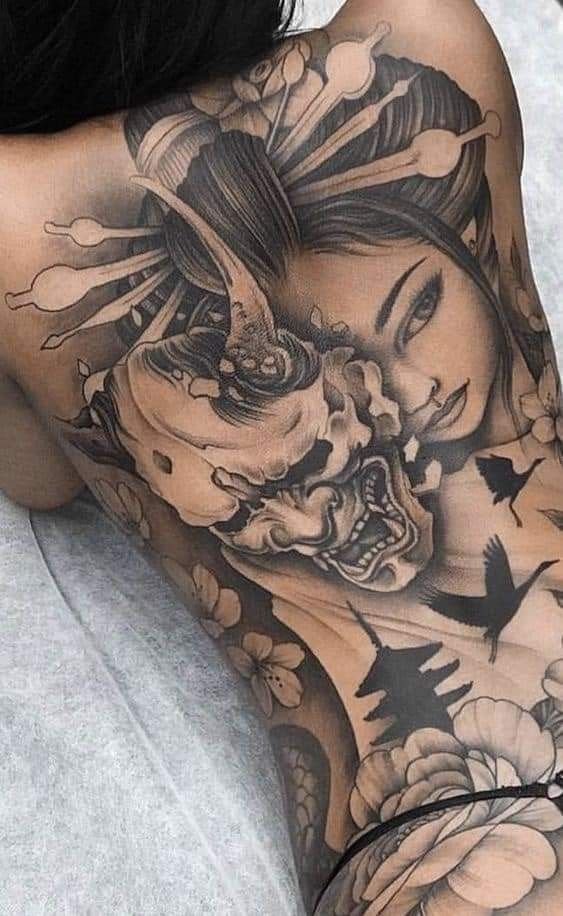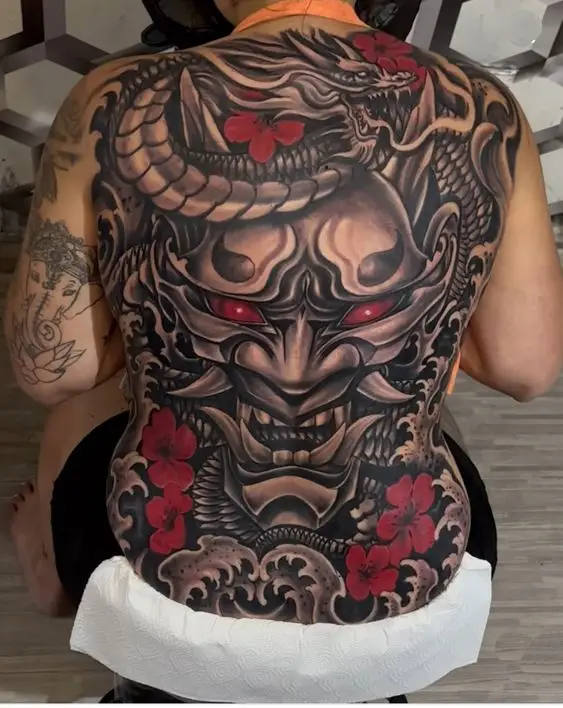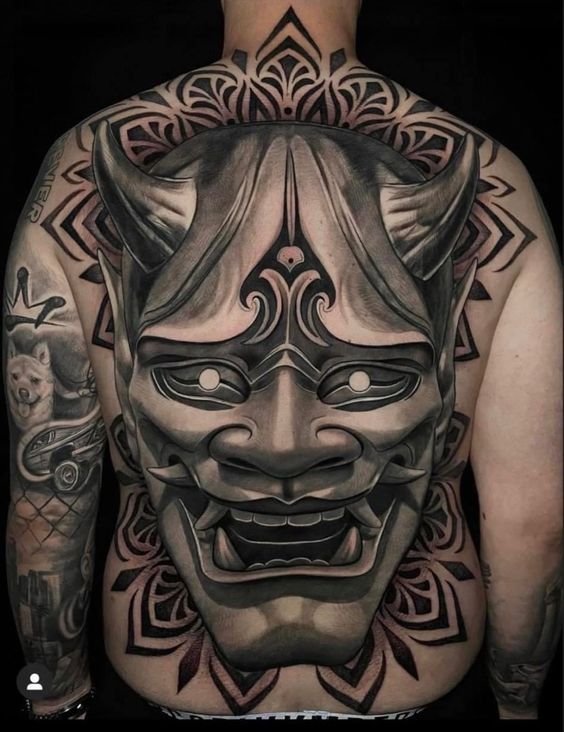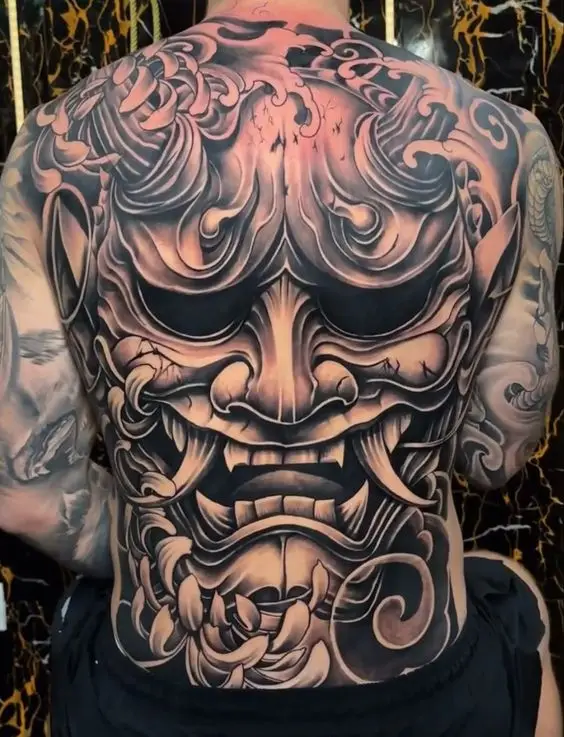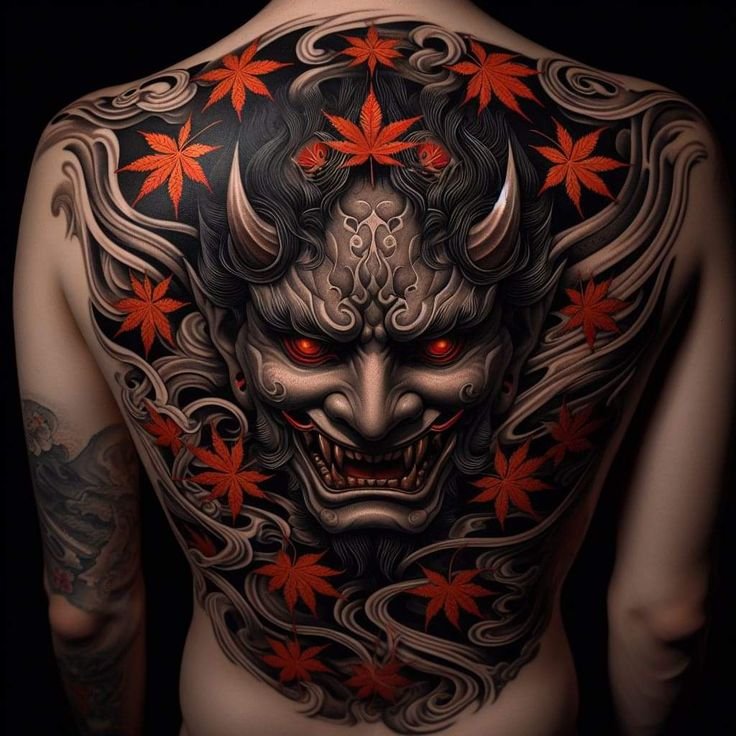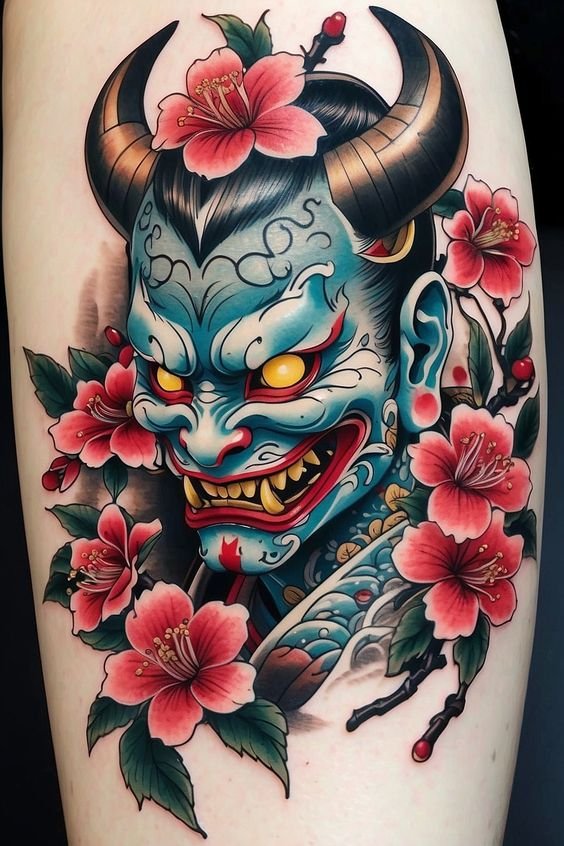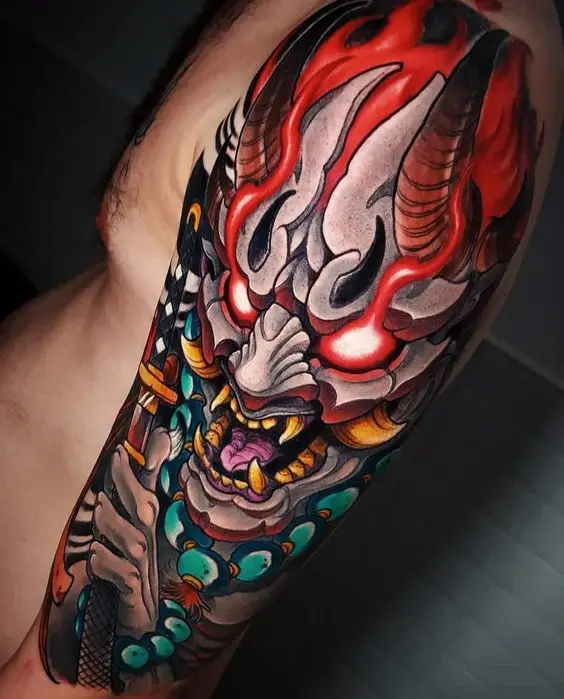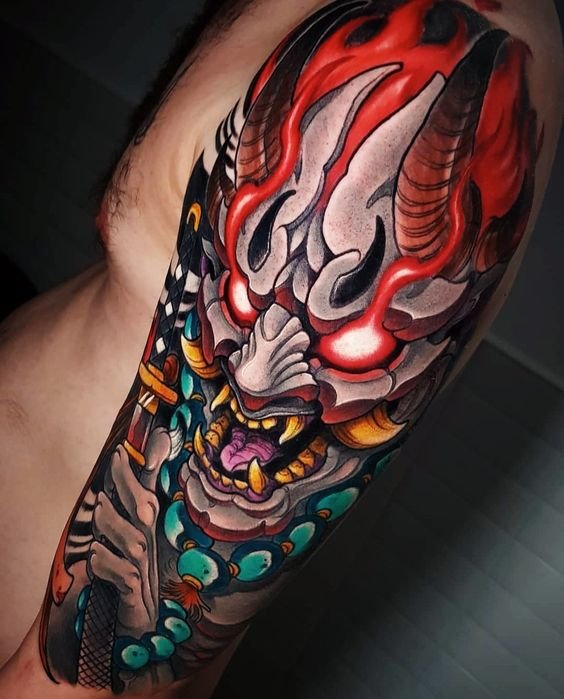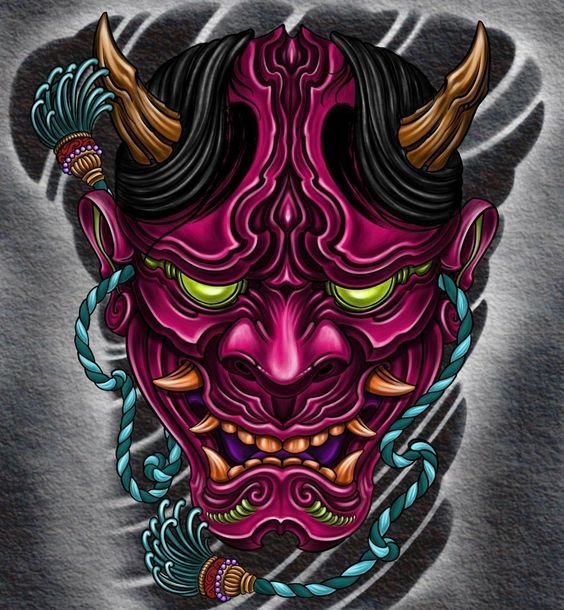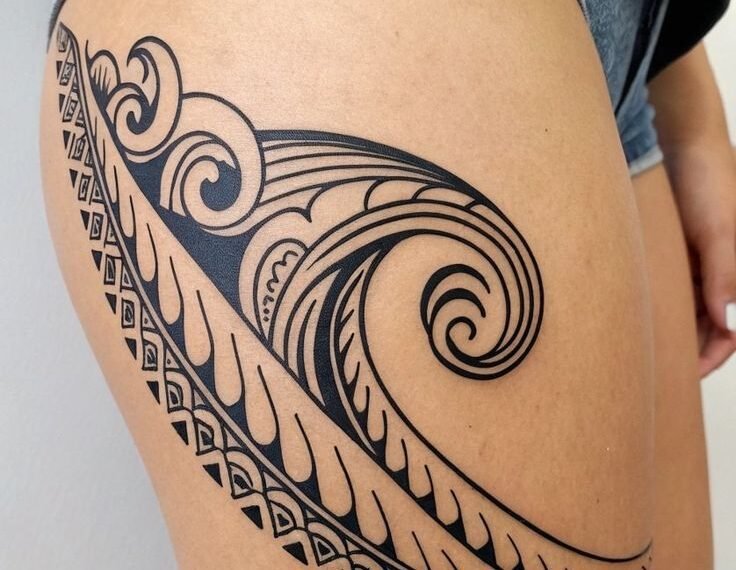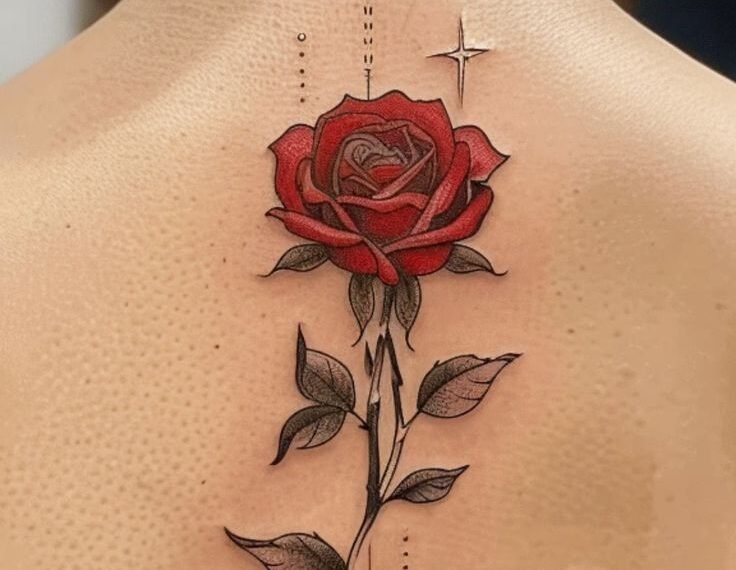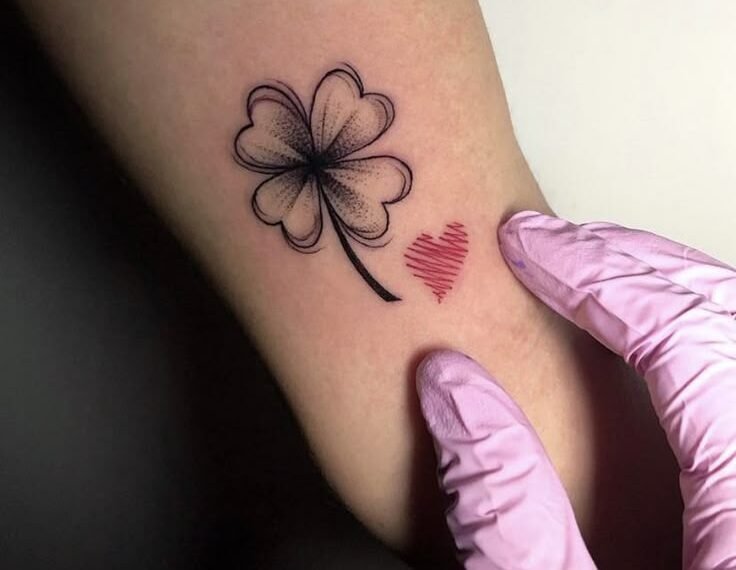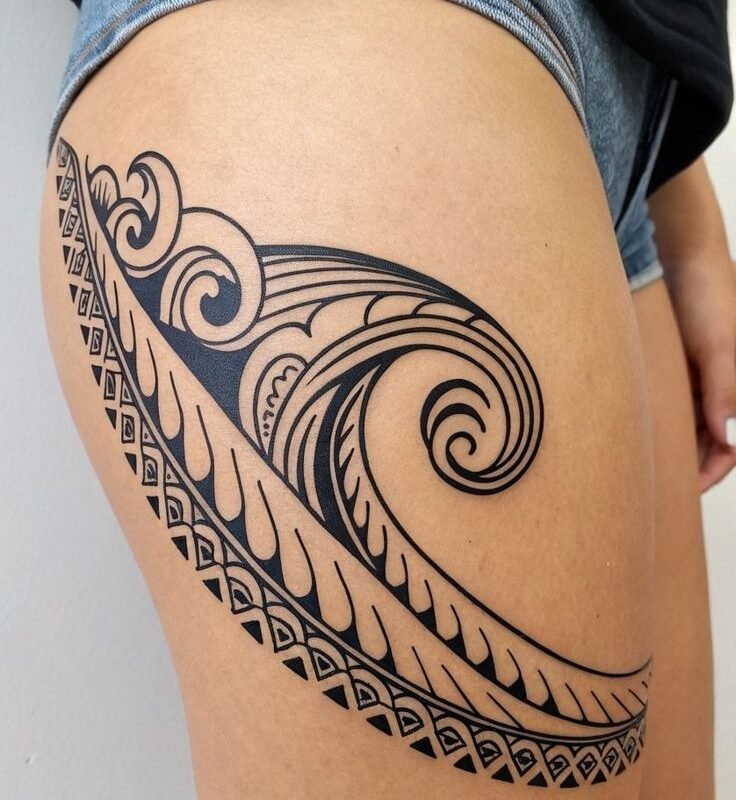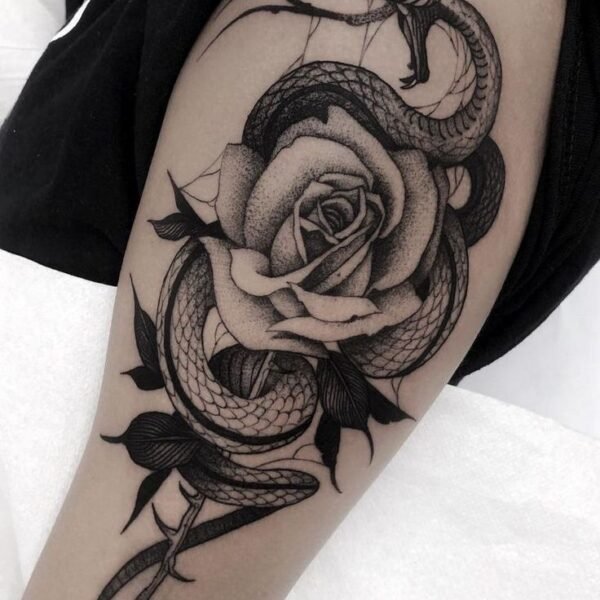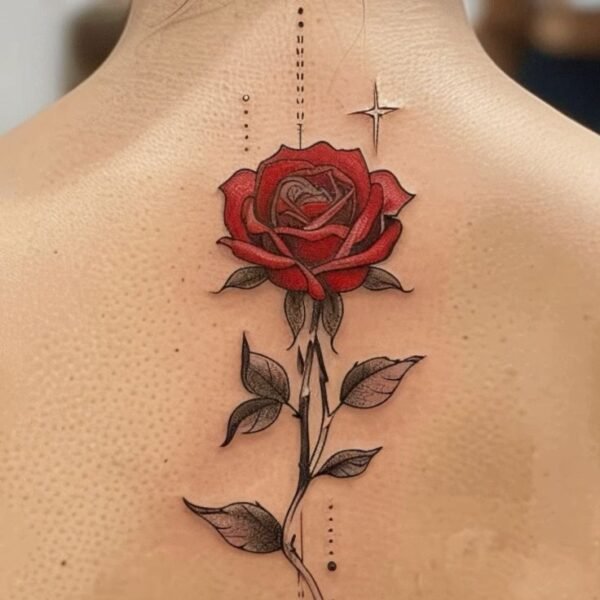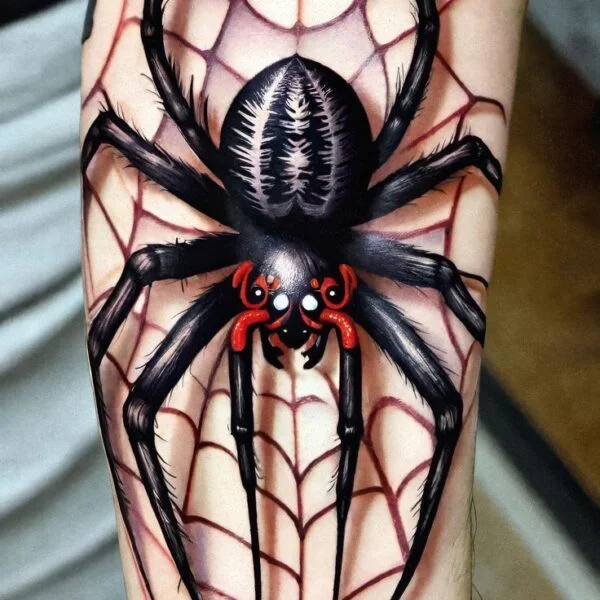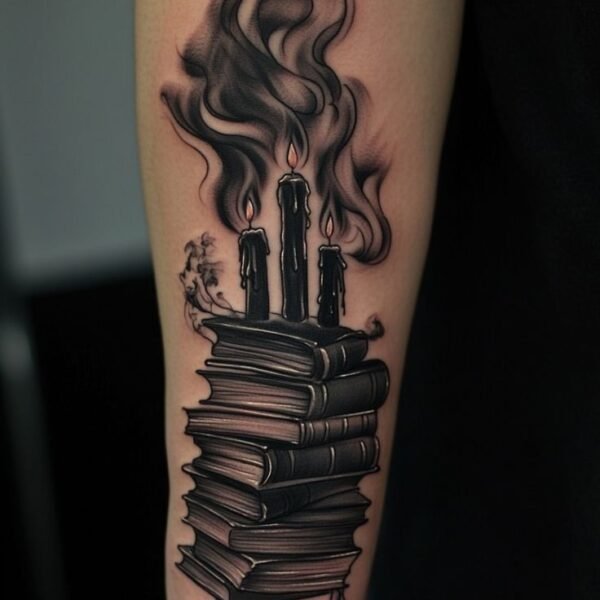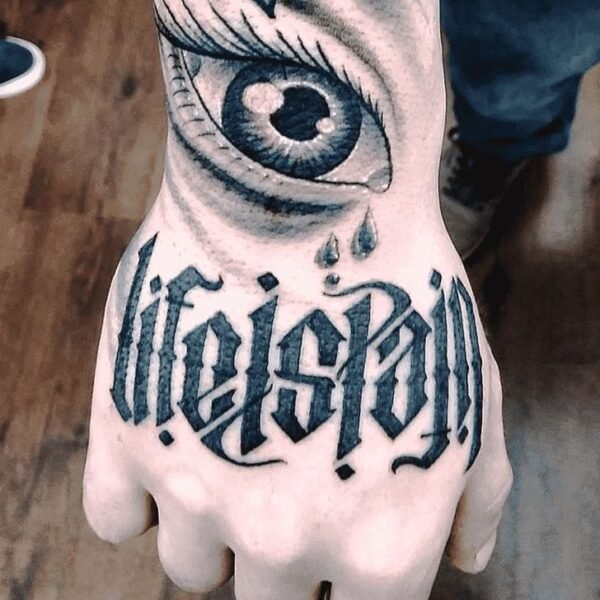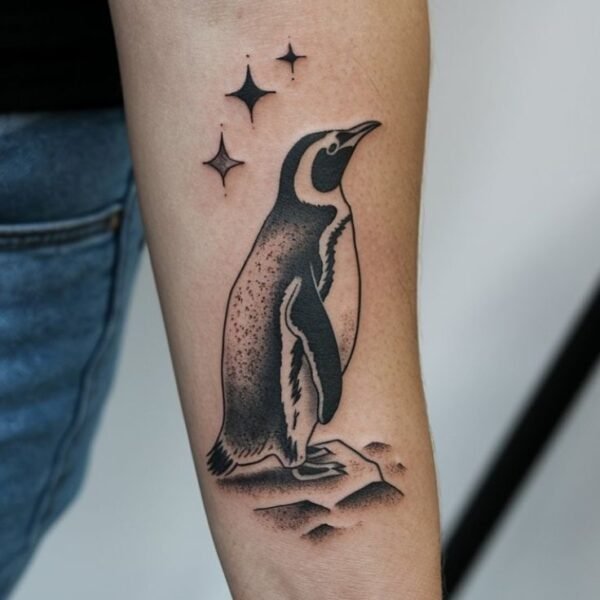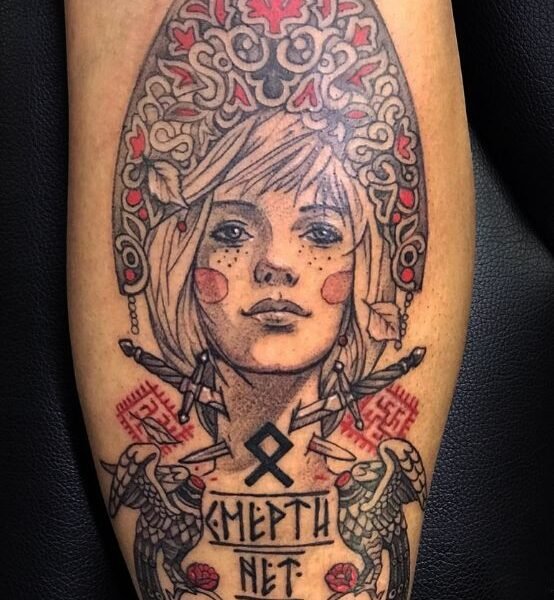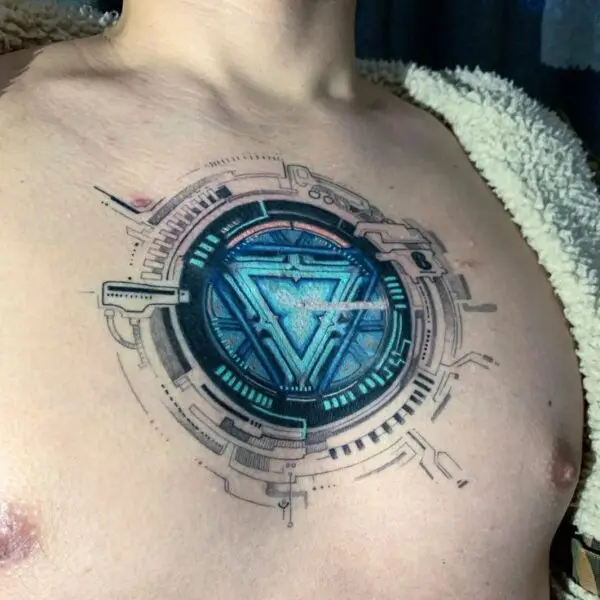Have you ever thought about what an Oni mask tattoo means? These tattoos are fascinating, with deep roots in Japanese history and symbolism. They are more than just eye-catching pictures. They’re believed by some to ward off misfortune and offer protection. But, what exactly is their message? What does an oni mask tattoo mean?
The history behind Oni masks is quite interesting. Originally, they were in stage performances and are now a popular tattoo choice. They are seen as offering protection from evil. It’s like they carry the power to punish bad actions, much like devils in stories.
There’s more to Oni mask tattoos than meets the eye. They can also represent facing your fears, dealing with your dark side, and seeking spiritual protection. These tattoos often stand for bravery and the strength to overcome challenges.
The tattoo’s color is not just for show. Traditional Oni mask tattoos are usually red or blue. Yet, you might see them in black, green, or yellow too. Each color has a special meaning, making the tattoo even more interesting.
Where you place your Oni mask tattoo is up to you. They can look great on the back, arms, shoulders, or even the neck. Because they are very detailed, they need a good amount of space. They are seen as a big artistic and financial investment.
To get the best Oni mask tattoo, find a skilled Japanese tattoo artist. In Perth, Western Australia, there are places that excel at Japanese tattoos. They offer advice on your design before you commit.
Interested in learning more about Oni mask tattoos? For deep insights into their meaning and history, visit Tattmag, Saved Tattoo, and Japanese Tattoo.
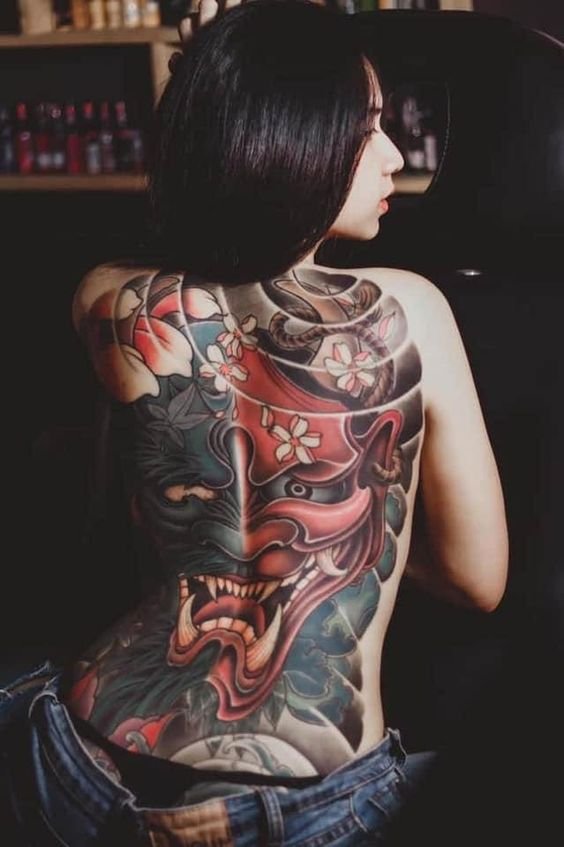
The History of Japanese Oni Masks
Oni masks are deeply rooted in Japanese tradition. The word “Oni” comes from “on,” which means “to hide.” Initially, these masks were tied to evil, shown as ogres or demons causing disasters and wars. But as time passed, they began to look more human, though they still have two horns and an angry face.
The origins of Oni masks go way back to Hindu-Buddhist beliefs. They were especially important in Japanese art and theater, underlining their cultural significance. For centuries, these masks have mixed the idea of demons and bringing good luck.
In Japan, Oni masks are described as giant scary monsters with features like those of humans, but more frightening. They typically have sharp fangs, wild hair, and horns, and may have more than two eyes. People use these masks to protect against evil. Wearing Oni-themed jewelry is common, aiming to bring peace and good fortune. Moreover, these masks are thought to chase away evil spirits.
To make them more powerful, Oni masks might include parts of animals like foxes or snakes. This touch comes from Japanese stories and brings an extra depth to the masks.
Japanese masks are known from as far back as the 6th century, showing they’ve been part of Japanese life for a long time. Over the years, Oni masks have changed but stayed key in Japanese culture. They stand for strength and protection. They are vital in Japanese rituals and festivals like Setsubun.
If you want to know more about Oni masks’ meanings, check out this website for a detailed dive. For an Oni mask tattoo, choose a skilled artist in the Japanese style. They will help the design fit well on your body. In Perth, Western Australia, professional tattoo artists can give the best advice on creating an Oni mask tattoo.
What Do Oni Masks Represent?
Oni masks hold many meanings, which draws people to them in Japan. They used to stand for frightening things like deception and hatred. People saw them as evils causing wars and bad weather. But, the view of these masks has changed over time.
Now, Oni masks are seen as brave symbols in Japan. People wear them at festivals to stay safe from bad luck. These masks look like fierce demons with red faces and horns. They make a strong and protective statement against evil. In the past, they were brightly colored, showing their importance even more.
Oni masks come from Japan’s old stories about Oni, mythical creatures. It’s believed they can protect from bad spirits and bring luck. They are a powerful and protective symbol in Japan’s traditions.
Oni masks are not just for ancient ceremonies; they inspire modern art too. Today, you can see them in tales, tattoos, and jewelry. Oni masks show the blend of old beliefs and new ideas. They are the most famous traditional Japanese masks.
In Japanese plays, Oni masks are key, used in traditional acts and events. Samurai warriors would wear them, looking like fierce demons. This was to protect their face and scare their foes. While some debate if these masks were Oni-specific, they definitely represented power and protection.
Oni masks are also big in tattoo art. They are popular for their rich meaning. Mixing an Oni mask with a snake or dragon adds deeper symbolism. A snake symbolizes overcoming hardships, while a dragon suggests harmony in opposing qualities.
Remember, using Oni masks in tattoos needs thought and care. It’s important to respect their original culture. This way, the true meaning of Oni masks stays strong.
Oni masks combine Japan’s old myths with today’s art. They stand for power and protection. This makes them an interesting part of Japanese culture.
Why Were Oni Masks Worn?
The use of Oni masks in Japan has changed through the years, with unique meanings and roles. In the past, people wore these masks for different reasons and ceremonies.
Oni masks were mainly worn to keep evil spirits away and avoid bad luck. They were thought to have the power to frighten off bad forces. This protected the wearer and those around them at events like festivals.
In Noh theater, the masks were used to show evil or demon-like characters. The masks’ dramatic looks and designs helped actors tell stories and share emotions.
During fights, samurai used masks like these to protect their faces and scare enemies. The scary look of the Oni masks gave samurais an edge. Enemies would be afraid, which helped the warriors fight better.
Over time, Oni masks have become famous outside Japan. They are now well-known symbols in anime, manga, and games. These masks often represent mighty and magical beings.
But, the masks are still important in Japanese culture today. They are seen in art, pop culture, and as tattoos. Oni mask tattoos show strength and the ability to overcome difficult times. They appear on hands, arms, and chests, representing victory over evils.
You can learn more about Oni masks and Japan’s culture through these links:
- Seikatsumi for a deep dive into the symbolism of Japanese Skull & Oni Mask Tattoos.
- Japanese Oni Masks for a complete guide to different Japanese masks and their meanings.
- Adrenaline Studios for Japanese Oni Demon Mask Tattoo designs and ideas by Ron Smith, a well-known Japanese tattoo artist.
Oni Masks in Recent Times
The Oni masks have become really popular again. This is especially true in tattoos. People love getting Oni mask tattoos more these days.
These tattoos are known for their bold look and what they mean. People want Oni mask tattoos for their looks and the stories they tell.
Oni masks come from Japanese stories. They’re now very popular in tattoos because they look so detailed and interesting.
In Japanese culture, Oni masks stand for both good and evil. This mix often attracts people. They want their tattoos to mean protection and strength.
There’s a big interest in tattoos that come from folklore. People like showing off their background with some deep symbols.
Oni mask tattoos are seen as strong symbols against negativity. They’re about protection and strength. Many find this meaningful for their tattoos.
So, Oni masks are back in style, mainly in tattoos. Their look and what they stand for are very powerful. They mean a lot to people who love tattoos.
Oni Mask Tattoos
Oni mask tattoos are very popular now. They are loved for what they symbolize and how they look. People get these tattoos because they want to believe in good and evil. And also to feel protected by spiritual forces.
Many choose black ink for Oni mask tattoos. This color means being able to tell right from wrong. It shows the strength needed to face hard times and win against them.
Red Oni mask tattoos mean a lot too. They stand for power, passion, and being protected from bad things. The bright red color shows life and how we fight against bad times.
Sleeves with Oni masks are in high demand. They are big and catch the eye. With a lot of space, artists can create detailed and beautiful Oni mask designs.
Not just black and red, Oni mask tattoos come in many colors like blue and yellow. Adding color makes these tattoos even more interesting. It lets people show their unique style.
For extra strength and protection, some choose bigger Oni mask tattoos. Putting these on their chest, back, or thigh makes a powerful statement. It shows they are tough and won’t let bad things get to them.
Smaller Oni mask tattoos are also popular. They are quick to get and can be colorful. For many, they are a quiet but strong way to say they are safe and strong inside.
People like Oni mask tattoos for what they mean. They are a symbol of finding your inner strength. They encourage us to face any challenge life throws at us.
A favorite mix of colors for these tattoos is black and red. It represents being vengeful yet honest. This shows the deep and sometimes complicated nature of people.
In contrast, yellow Oni mask tattoos mean purity and peace. They protect against bad energies. They are a sign of finding balance and calm inside.
It’s important to know that Oni and Hannya tattoos are not the same. Both show demons from Japanese tales. But Oni masks show male demons, while Hannya masks show female ones.
Choosing an Oni mask tattoo means a unique and meaningful addition to your body. With their deep meaning and beautiful designs, they represent your faith, strength, and protection against bad things.
Symbolism and Meanings of Oni Mask Tattoos
Oni mask tattoos are big in Japan, standing for protection and strength. They link to the idea of spiritual significance. People who pick these tattoos believe in both good and evil. They want to protect themselves from bad vibes.
The piece talks about 10 Oni mask tattoo designs. Each design tells its own story. Oni masks can be in many colors. This means there’s a lot to choose from when getting a tattoo.
Hannya and Oni masks are common in Japanese ink. The article shows 10 colorful Oni mask tattoos. They use many colors like red, blue, and vibrant tones to show different meanings, like power and protection.
There are many spots for an Oni mask tattoo. People often pick the chest, thigh, arm, or even the palm. This piece gives tips on where to place your tattoo.
Oni mask tattoos are about keeping evil away. Different colors mean different things. For example, red stands for power, blue for change, and yellow for peace.
Oni mask tattoos are not just symbols. They look good, too. They are also popular at Japanese events. They show courage and the spirit of a fighter.
The article also looks at Skull & Oni Mask tattoos. They have been around since the 1600s. These tattoos mix art with meaning. They show bravery and how we can win over tough times.
Today, tattoo artists make Japanese Skull & Oni Mask designs their own. They create everything from very real to more artsy looks. There’s even a cool design with a Samurai in an Oni mask. This design is about being strong, noble, and brave.
In the end, Oni mask tattoos are more than ink. They stand for strong feelings in Japanese culture. They show courage and a fight against evil. They prove how art and meaning mix in tattoos.
Japanese Skull & Oni Mask Tattoos
Japanese Skull & Oni Mask Tattoos mix two strong symbols. The skull shows change and respect for the dead. It also reminds us life is short. Oni masks stand for protection and facing challenges with power. Together, they tell a bold story of life and purpose.
Started in the Edo period, Japanese tattoos called Irezumi have a long history. Skull tattoos have evolved since the 1600s, showing their deep cultural meaning.
Artists combine various styles for these tattoos, mixing realism with unique designs. This blend shows the skill and creativity of tattoo art today.
Tattoos often include traditional masks. Oni masks are for protection in Japanese stories. They help fight evil and beat challenges.
Skull tattoos have transformed from being taboo to admired. They represent courage and victory over tough times. Oni mask tattoos keep their popularity, symbolizing luck, fortune, and fear for foes.
Japanese masks, dating back to the 6th century, are a key part of Japan’s culture. Oni masks, known for their demon-like look, are very famous. They often have horns and fangs, in red or blue.
In summary, Japanese Skull & Oni Mask Tattoos are bold and rich in symbols. They stand for change, protection, and strength. These tattoos honor Japanese culture while celebrating personal strength and courage.
Symbolism and History of Japanese Skull & Oni Mask Tattoos
Japanese Skull & Oni Mask Tattoos have deep meanings and a long history in Japan. The skull in tattoos shows that life is short, so we should value every moment and understand that life will end. Oni masks, on the other hand, represent the power to face evil and overcome challenges.
These tattoos are loved worldwide. People are inspired by designs like Oni Skull Mask, Traditional Oni Mask, Female Oni Mask, and those with Japanese symbols, Cherry Blossoms, or Samurai Swords.
There are many places on the body where you can get these tattoos. Some like them on their head, leg, chest, spine, forearm, sleeve, or torso. The forearm is popular because it’s easy to see, but the torso allows for bigger, detailed art.
Tattoo artists often add swords, cherry blossoms, samurai swords, or snakes for extra meaning. These symbols are from Japanese culture and make the tattoos more special.
Japanese Skull & Oni Mask Tattoos are not just for looks. They also protect, telling personal stories and dreams. They link the past with the present, showing the beauty of Japanese traditions and symbols.
FAQ
What Does an Oni Mask Tattoo Mean?
An Oni mask tattoo shows strength and power. It protects against danger and evil spirits. Wearers believe it brings good luck.
What is the History of Japanese Oni Masks?
Japanese Oni masks date back in culture, representing evil spirits. They were seen as monsters with red faces and two horns.
This image came to life over centuries. Now, they stand for strength more than evil.
What Do Oni Masks Represent?
Oni masks once symbolized fear, deception, and hatred. They were linked to causing disasters.
Today, they are talismans of protection and strength. They show how darkness can turn into power.
Why Were Oni Masks Worn?
Japanese people wore Oni masks to keep away spirits and bad luck. They were part of festivals, parades, and Noh theater.
In Noh theater, actors used them to play evil spirits.
How are Oni Masks Perceived in Recent Times?
In today’s world, Oni masks are seen differently. Originally seen as evil, now they are symbols of strength.
They are featured in various art forms and as tattoos.
What is the Meaning of Oni Mask Tattoos?
Oni mask tattoos symbolize protection and strength. They help people face their challenges.
Sometimes, they can represent embracing our dark side or overcoming fears.
What are the Symbolism and Meanings of Oni Mask Tattoos?
Oni mask tattoos symbolize strength and protection from evil.
For some, they ward off bad luck. For others, they show a strong will to win.
What are Japanese Skull & Oni Mask Tattoos?
Japanese Skull & Oni Mask Tattoos combine two powerful symbols.
They blend skulls, which signify change and impermanence, with Oni masks’ strength.
What is the Symbolism and History of Japanese Skull & Oni Mask Tattoos?
These tattoos have deep meanings and a long history. They urge living with purpose and acknowledging life’s shortness.
They honor Japanese spirituality and culture.
I’m a tattoo enthusiast with a love for all things ink. Besides tattoos, I’m into tech, hitting the road for spontaneous trips, and enjoying a good whiskey. I’m also fascinated by the historical aspects and meanings behind tattoos, which is why I created Tattoo Pub. When I’m not on an adventure or geeking out over the latest gadgets, you’ll find me curled up with a good book. Always on the lookout for new experiences and stories to share!

